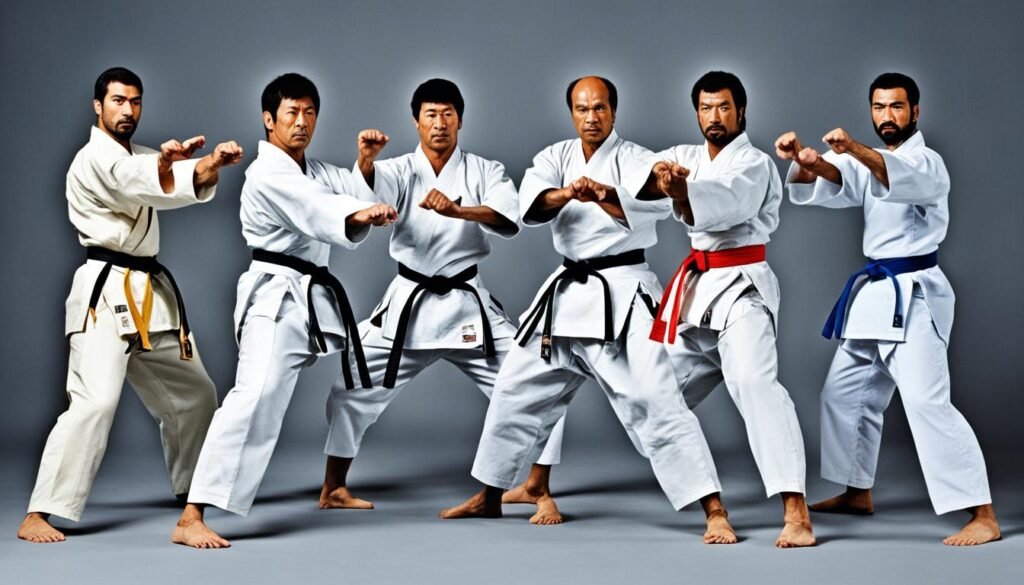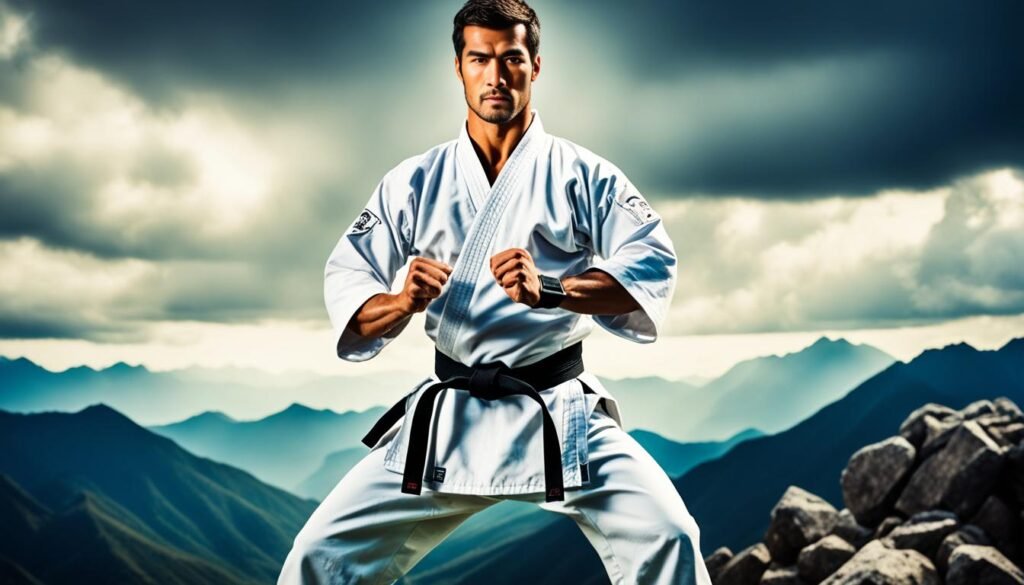Karate, also known as karate-do, is a martial art that originated in the Ryukyu Kingdom, which is present-day Okinawa prefecture in Japan. The art of Karate developed from the indigenous martial arts of the Ryukyu Islands, influenced by Chinese martial arts. While modern karate focuses on striking techniques such as punches and kicks, ancient karate also incorporated jujutsu techniques like throws and joint locks.
The Ryukyu Kingdom was conquered by Japan in the 17th century, and during the Taishō era, karate was introduced to mainland Japan by Gichin Funakoshi and Motobu Chōki. Karate gained popularity in Japan and eventually spread globally, becoming one of the world’s most popular martial arts.
Karate emphasizes not only physical techniques but also spiritual cultivation and the development of character. It has been recognized as an Olympic sport and has millions of practitioners worldwide. If you ever asked yourself “What is Karate?” then this article is for you!
Key Takeaways
- Karate originated in the Ryukyu Kingdom in present-day Okinawa, Japan.
- Ancient karate included striking and jujutsu techniques.
- Karate was introduced to mainland Japan in the Taishō era.
- Karate focuses on physical techniques and character development.
- Karate is recognized as an Olympic sport.
Origins of Karate and its Development in Okinawa
Karate, a martial art renowned for its striking techniques, has its roots in the island of Okinawa, once known as the Ryukyu Kingdom. The path to the development of Karate began with the indigenous martial arts of Okinawa, which were heavily influenced by Chinese martial arts.
The Ryukyuans crafted a closed-fist fighting system called “te,” which embodies the essence of Karate. The Chinese influence on Okinawa’s martial arts can be attributed to interactions with Chinese visitors and exchanges with Shaolin monks. Over time, these techniques evolved and were refined due to Japan’s prohibition on weapons in Okinawa during the 17th century.
Three cities in Okinawa played a pivotal role in the development of various Karate styles, collectively known as Okinawa-Te. Shuri, Tomari, and Naha became hotbeds of martial arts, where techniques and philosophies intertwined, shaping the future of Karate.
During the Taishō era, Gichin Funakoshi and Motobu Chōki introduced Karate to mainland Japan. This marked a significant turning point in the history of Karate, leading to its widespread popularity in Japan and eventually around the globe.
Chinese Influence on Okinawa’s Martial Arts
“The influence of Chinese martial arts on Okinawa’s indigenous fighting systems is undeniable. The exchange of knowledge and techniques between Okinawa and China played a crucial role in shaping the development of Karate.”
Throughout history, Okinawa served as a crucial trading hub between China and Japan. This facilitated the exchange of martial arts practices, leading to the incorporation of Chinese techniques in Okinawa’s fighting systems.
The indigenous martial arts of Okinawa gradually evolved as Okinawans embraced Chinese influences, resulting in the birth of Karate as it is known today. The integration of Chinese principles and techniques enriched Okinawa’s martial arts, making it a formidable and distinct form of self-defense.
The Influence of Okinawa’s Three Cities
“Shuri, Tomari, and Naha were instrumental in shaping the diverse Karate styles that emerged from Okinawa. These cities served as breeding grounds for some of the most renowned Karate masters in history.”
Shuri, the capital city of the Ryukyu Kingdom, was a melting pot of cultures and ideas. It became a center for martial arts, where techniques from indigenous Okinawan styles and Chinese influences merged, creating a unique Karate style.
Tomari, a port city with a vibrant trading community, also played a vital role in the development of Karate. The exchange of knowledge between sailors and merchants enriched the martial arts practiced in Tomari.
Naha, another prominent city in Okinawa, served as a hub for maritime trade and cultural exchange. Its location made it an essential stopover for merchants and travelers, who brought with them new knowledge and techniques. Naha’s influence contributed significantly to the evolution and refinement of Karate.
These three cities collectively shaped the development of Okinawa-Te, providing a rich foundation for the growth and global popularity of Karate.
Book Recommendation
This is a create book to learn about the history, philosophy and the creation of Karate!
Spread of Karate in Japan and the United States
Gichin Funakoshi, the founder of modern karate, played a crucial role in spreading karate in Japan. His demonstration impressed the public and Crown-Prince Hirohito, leading to the acceptance of karate. Funakoshi was invited by Dr. Jano Kano, the founder of Judo, to demonstrate karate at his dojo and teach karate in Japan. This support from Dr. Kano helped establish karate in Japan and led to the founding of karate schools, including the four main styles of Wado-ryu, Goju-ryu, Shito-ryu, and Shotokan.
Gichin Funakoshi’s dedication to promoting karate in Japan opened the doors to the establishment of numerous karate schools and the development of various styles, each with its unique techniques and philosophies.
In the United States, karate was first introduced in 1942 by Robert A. Trias, who learned the martial art while serving in the US Navy. Trias opened the first karate school in the US in 1946 and founded the United States Karate Association.
“Robert A. Trias’s contribution to the popularity of karate in the United States cannot be overstated. His pioneering efforts laid the foundation for the growth and development of karate schools across the country.”
Since then, many individuals have opened karate schools across the United States, further contributing to the popularity and widespread practice of karate. Today, karate schools can be found in various cities and states, offering training to practitioners of all ages and skill levels.

Overall, Gichin Funakoshi’s efforts in Japan and Robert A. Trias’s establishment of the first karate school in the United States have played pivotal roles in the global spread and acceptance of karate.
Principles and Techniques of Karate
Karate practice encompasses three essential components: kihon (basics), kata (forms), and kumite (sparring). Each component plays a crucial role in developing a well-rounded karate practitioner.
Kihon: Building a Strong Foundation
In kihon, practitioners focus on mastering the fundamental techniques and movements that serve as the building blocks of karate. These include strikes, blocks, kicks, and stances. By honing these fundamental skills, students develop the core mechanics and body mechanics required for effective self-defense.
The repetitive practice of kihon helps instill muscle memory, allowing practitioners to react swiftly and instinctively in real-life combat situations. Moreover, kihon promotes proper body alignment, balance, and coordination, enhancing not only physical prowess but also overall fitness.
Kata: The Art of Forms
Kata refers to a predetermined sequence of movements that embody the principles of self-defense. Practitioners perform these forms solo, utilizing a range of techniques and stances specific to their chosen karate style. Through the practice of kata, students develop coordination, balance, agility, strength, and speed.
Each kata serves as a repository of techniques and principles passed down through generations, allowing practitioners to train even in the absence of a training partner. The performance of kata promotes mental focus, discipline, and concentration, as practitioners strive for precision and fluidity in their movements.
Kumite: Applying Techniques in Combat
Kumite involves the practical application of the techniques and principles learned in kihon and kata against an opponent. It encompasses both controlled sparring and free-style fighting, allowing practitioners to develop their timing, distance management, and decision-making skills under pressure.
Through kumite, students gain a deeper understanding of the effectiveness and limitations of each technique. It also cultivates mental fortitude, resilience, and adaptability in the face of ever-changing combat scenarios.
Colored Belt System: Measuring Progress
Karate employs a colored belt system to signify the progression of students’ skills and knowledge. Beginning with a white belt, students gradually work their way up through a series of colored belts, including yellow, orange, green, blue, purple, brown, and finally, black belt ranks.
Each belt represents a milestone in the practitioner’s journey, reflecting their mastery of specific techniques, knowledge of theory, and growth in physical and technical abilities. The colored belt system provides students with a tangible way to set goals, track their progress, and stay motivated on their path towards mastery.
The pursuit of excellence in karate extends beyond physical conditioning alone. It emphasizes the development of character, self-discipline, and respect for oneself and others. As students progress through the principles and techniques of karate, they not only gain the skills necessary for self-defense but also cultivate a sense of personal empowerment and inner strength.
| Karate Component | Description |
|---|---|
| Kihon | Focus on fundamental techniques and movements used in self-defense |
| Kata | Predetermined pattern of movements promoting self-defense principles and coordination |
| Kumite | Application of techniques and principles in sparring and combat scenarios |
| Colored Belt System | Progression and measurement of skills and knowledge |
Conclusion
Karate is a highly effective system of self-defense that offers a multitude of benefits for practitioners. Through the practice of karate, individuals can improve their physical conditioning, coordination, and self-confidence. The art of karate promotes mental discipline, character development, and a sense of personal growth.
With its origins in the Ryukyu Kingdom and influenced by Chinese martial arts, karate has evolved into a global phenomenon. It has gained recognition as an Olympic sport, further highlighting its popularity and significance.
Whether practiced for self-defense, competition, or personal growth, karate provides a comprehensive training experience. The range of techniques and training methods allow practitioners to set goals and measure their progress through the colored belt system.
Overall, the practice of karate offers both physical and mental benefits. It improves fitness, enhances self-discipline, and fosters a resilient character. The journey the practitioner embarks on through karate is one of continuous growth and self-improvement, making it a highly valuable martial art.
FAQ
What is karate in simple words?
Karate is a Japanese martial art focused on defensive and counterattacking movements, emphasizing physical and mental well-being through empty-handed techniques.
What is karate do in martial art?
Karate-do, or the “empty hand way,” involves systematic training of arms and legs for self-defense, contributing to both physical and mental improvement.
What is the sport karate about?
Karate as a sport includes unarmed martial arts disciplines, emphasizing techniques like kicking, striking, and defensive blocking for physical fitness and skill development.
What fighting is karate?
Karate, an unarmed martial art, incorporates thrusts, kicks, and arm strikes, focusing on efficient execution of defensive and counterattacking movements.
What is the history of karate?
Karate originated in the Ryukyu Kingdom, present-day Okinawa prefecture in Japan, and was influenced by Chinese martial arts. It was introduced to mainland Japan in the early 20th century.
What is karate?
Karate is a martial art that originated in Japan and emphasizes striking techniques such as punches and kicks.
What are the techniques of karate?
Karate techniques include punches, kicks, strikes, blocks, throws, joint locks, and sparring.



